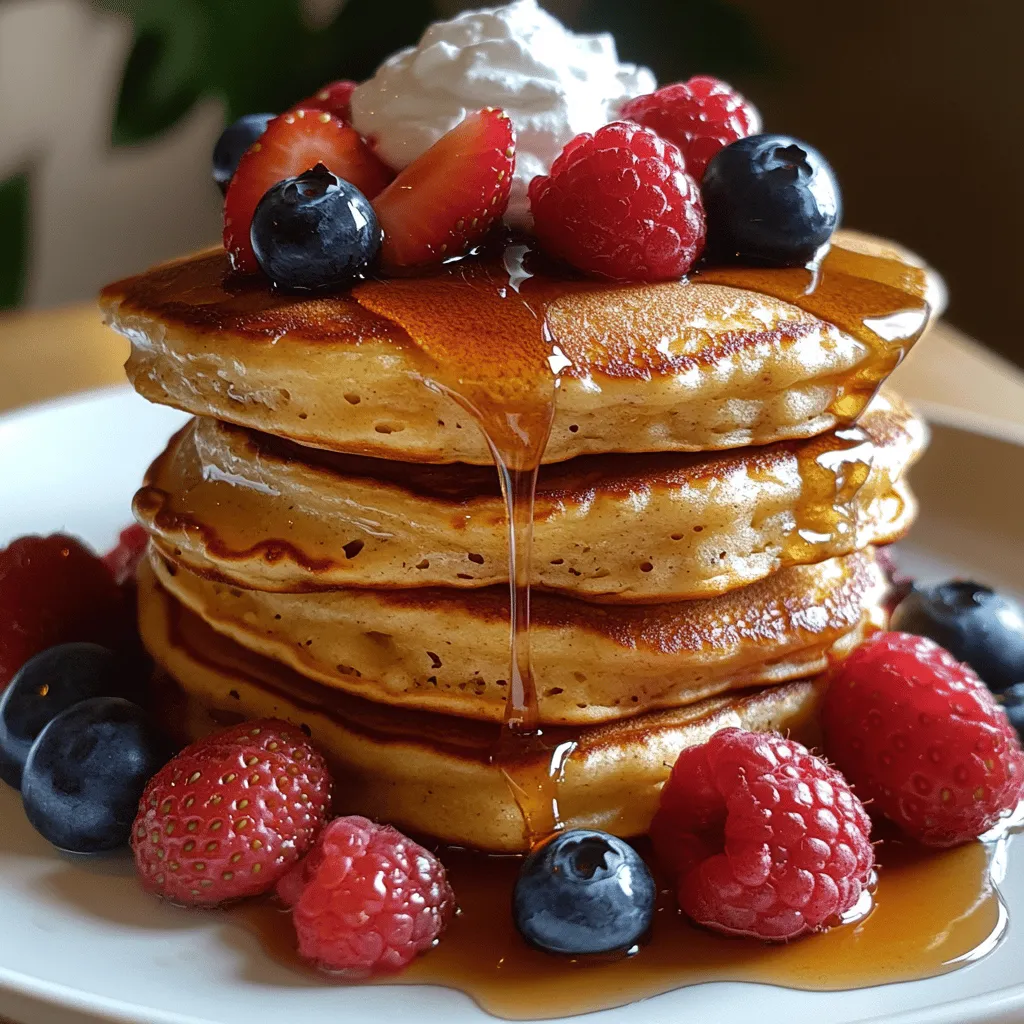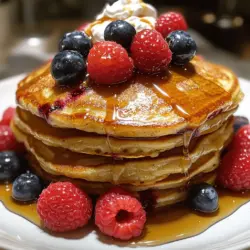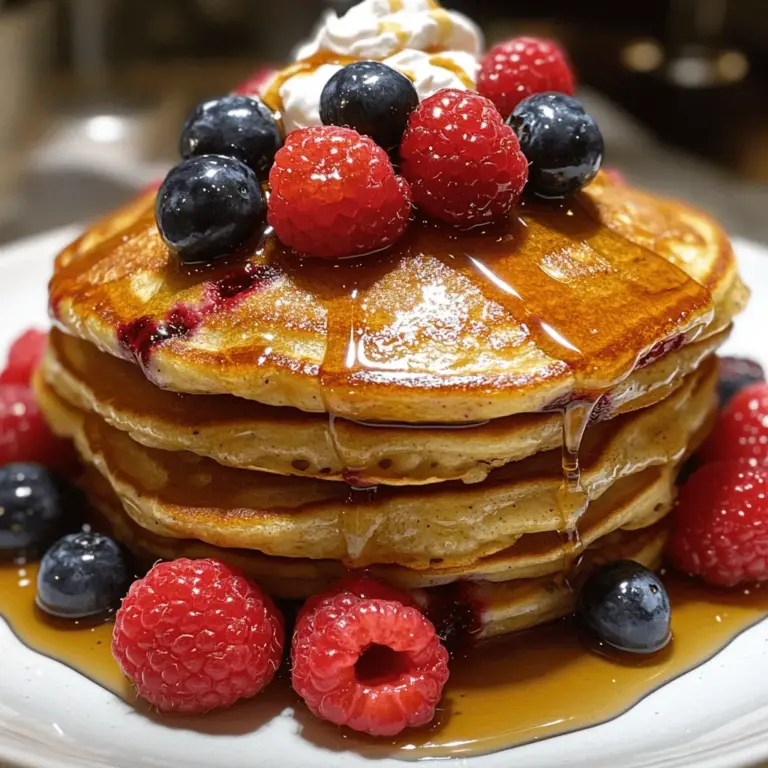Introduction
Pancakes have long held a special place in breakfast culture around the world, offering a warm, comforting start to the day. From the classic American breakfast to various international takes, pancakes are beloved for their versatility and ease of preparation. They can be served with a myriad of toppings, making them a blank canvas for creativity. Among the different varieties, buttermilk pancakes stand out as a quintessential favorite, cherished for their airy texture and rich, buttery flavor.
What sets buttermilk pancakes apart is their ability to strike a balance between fluffiness and tenderness, creating a delightful mouthfeel that is hard to resist. The incorporation of buttermilk not only enhances the flavor profile but also contributes to the pancakes’ lightness, making them a go-to choice for breakfast enthusiasts and home cooks alike. This recipe is particularly significant for those looking to impress family or guests with minimal effort, as the ingredients are simple and the steps straightforward, leading to consistently delicious results.
Whether you’re a seasoned chef or a novice in the kitchen, mastering the art of buttermilk pancakes is an essential skill. This recipe ensures that you not only produce pancakes that are fluffy and flavorful but also brings joy to your breakfast table. So, let’s delve into the ingredients that make these pancakes so special before we jump into the cooking process.
Understanding the Ingredients
To make the perfect fluffy buttermilk pancakes, it’s crucial to understand the role of each ingredient in the recipe. Each component contributes to achieving the desired texture, flavor, and overall success of the pancakes.
All-Purpose Flour
All-purpose flour serves as the foundation of pancake structure and texture. It contains a moderate amount of protein, which is essential for gluten development. When mixed with liquid, the flour creates a network that gives the pancakes their shape. For optimal results, it’s advisable to spoon the flour into the measuring cup and level it off with a knife to avoid packing, which can lead to dense pancakes.
Granulated Sugar
Granulated sugar is not just for sweetness; it also plays a crucial role in enhancing caramelization during cooking. This caramelization contributes to the golden-brown exterior of the pancakes while providing a touch of sweetness that balances the tanginess of the buttermilk. A small amount of sugar can also help to tenderize the pancakes, making them melt in your mouth.
Baking Powder and Baking Soda
Baking powder and baking soda are key leavening agents that work together to create fluffiness in pancakes. Baking powder is a double-acting leavening agent that releases carbon dioxide when it comes in contact with moisture and heat, giving the pancakes their rise. Baking soda, on the other hand, requires an acid to activate; in this recipe, the buttermilk serves this purpose. Together, they ensure that the pancakes are light and airy.
Salt
While salt may seem like a minor ingredient, it plays a vital role in balancing sweetness and enhancing flavor. It also helps to strengthen the gluten network formed by the flour, which contributes to the overall structure of the pancakes. Just a pinch can elevate the taste and bring out the other flavors in the recipe.
Buttermilk
Buttermilk is the star ingredient in this recipe, adding moisture and a distinctive tang that sets these pancakes apart. The acidity in buttermilk interacts with the baking soda, enhancing the leavening process and resulting in a light, tender pancake. Additionally, it adds a depth of flavor that regular milk simply cannot replicate. If you don’t have buttermilk on hand, you can easily create a substitute by mixing milk with a tablespoon of vinegar or lemon juice and letting it sit for a few minutes.
Egg
The egg in this recipe provides both structure and richness. It binds the ingredients together, ensuring that the pancakes hold their shape during cooking. The protein in the egg contributes to the overall texture, giving the pancakes a satisfying chew while also helping them rise.
Unsalted Butter
Unsalted butter adds flavor and moisture to the pancake batter. It’s important to use melted butter in the recipe as it combines easily with the wet ingredients, ensuring even distribution throughout the batter. This contributes to the rich taste and tender crumb of the pancakes. If you prefer, you can substitute with a neutral oil, but the flavor may be slightly different.
Vanilla Extract
Vanilla extract enhances the overall flavor profile of the pancakes, adding a warm, aromatic note that complements the other ingredients beautifully. It’s a simple addition that can make a significant difference in the final taste of your pancakes.
Optional Toppings
While buttermilk pancakes are delicious on their own, they become even more enticing with the addition of various toppings. Classic options include maple syrup, which offers a sweet, rich flavor that pairs perfectly with the pancakes’ fluffy texture. Fresh berries can add a burst of freshness, while whipped cream provides a light, airy contrast. Feel free to get creative with toppings like chocolate chips, nuts, or even yogurt for a twist on the traditional pancake experience.
Step-by-Step Guide to Making Fluffy Buttermilk Pancakes
Now that we’ve covered the key ingredients, let’s dive into the step-by-step process of making fluffy buttermilk pancakes. These instructions will help you achieve restaurant-quality pancakes right in your own kitchen.
Mixing Dry Ingredients
Begin by gathering all your dry ingredients in a large mixing bowl. This includes the all-purpose flour, granulated sugar, baking powder, baking soda, and salt. It’s essential to whisk these ingredients together thoroughly to ensure even distribution. This step not only combines the dry ingredients but also aerates the flour, which contributes to the fluffiness of the pancakes. Aim for a consistent mixture, free of any lumps.
Preparing Wet Ingredients
In a separate bowl, prepare your wet ingredients. This includes the buttermilk, egg, and melted unsalted butter. If you’re using a buttermilk substitute, make sure it has thickened slightly before adding it to the mix. Whisk the ingredients together until they are well combined. The melted butter should be slightly cooled before adding it to avoid cooking the egg. Incorporating the wet ingredients separately helps to ensure that the batter comes together smoothly without overworking the flour.
Combining Mixtures
Once you have your dry and wet ingredients prepared, it’s time to combine them. Make a well in the center of the dry ingredients and gently pour the wet mixture into it. Using a spatula, carefully fold the ingredients together. It’s crucial to avoid over-mixing at this stage. Over-mixing can lead to the development of too much gluten, resulting in dense pancakes instead of light, fluffy ones. Aim for a batter that is slightly lumpy; it’s okay if there are a few small flour streaks left.
Resting the Batter
After combining the ingredients, let the batter rest for about 5-10 minutes. This resting period allows the flour to fully hydrate and the leavening agents to activate. Resting the batter is a scientific approach that aids in improving the final texture of the pancakes. You’ll notice that the batter thickens slightly during this time, which is a good sign that your pancakes will be even fluffier.
Heating the Pan
While the batter rests, it’s time to heat your cooking surface. Preheat a non-stick skillet or griddle over medium heat. For optimal results, you want the cooking surface to be hot enough that a drop of water sizzles upon contact. Before pouring in the batter, lightly grease the pan with a small amount of unsalted butter or oil. This step is crucial for preventing sticking and achieving that perfect golden-brown color. Too much fat can lead to greasy pancakes, so a light coating is all you need.
With these initial steps completed, you’re well on your way to creating a stack of fluffy buttermilk pancakes that will be a hit at any breakfast table. Stay tuned for more detailed instructions on cooking and serving your pancakes, ensuring that your culinary adventure continues to delight!

Cooking the Pancakes
To achieve the ultimate fluffy buttermilk pancakes, it’s essential to know when to flip them. The signs of doneness can make or break your pancake experience. First, watch for bubbles forming on the surface of the pancake. When these bubbles start to pop and the edges appear slightly dry, it’s time to flip. This usually takes about 2 to 3 minutes on medium heat. Flipping too soon can lead to undercooked centers, while waiting too long may result in tough pancakes.
When you do flip them, use a spatula to gently turn the pancake over. The second side will cook quicker, usually within 1 to 2 minutes. You’ll know they are done when they are golden brown on both sides and spring back lightly when touched. Avoid pressing down on the pancakes as that can deflate their fluffy texture.
Keeping Warm
Once your pancakes are cooked, it’s important to keep them warm without compromising their fluffiness. Preheat your oven to a low temperature, around 200°F (93°C), and place a baking sheet lined with parchment paper inside. As you cook the pancakes, transfer them to the warm oven to keep them at a consistent temperature. This method helps maintain their warmth without further cooking them.
Another great option is to cover the pancakes with a clean kitchen towel, which helps retain moisture and warmth. Just be cautious not to stack them too high, as this could create steam and make them soggy.
The Science Behind Fluffiness
Understanding the science behind pancake preparation can elevate your pancake-making skills. The key to achieving that sought-after fluffiness lies in the chemical reactions during cooking. When you mix flour with liquid, gluten begins to form. While gluten provides structure, too much can lead to dense pancakes.
This is where buttermilk plays a pivotal role. Buttermilk is acidic, which interacts with baking soda to create carbon dioxide bubbles. These bubbles expand during cooking, resulting in light and airy pancakes. Additionally, the acidity of buttermilk tenderizes the batter, ensuring a soft texture.
Resting the batter is another crucial step. Allowing it to sit for about 5 to 10 minutes lets gluten relax, which leads to a more tender pancake. During this time, the flour also absorbs moisture, allowing for better air incorporation.
Variations and Customizations
One of the best aspects of fluffy buttermilk pancakes is their versatility. You can easily customize the recipe to suit your taste or dietary needs. For those seeking a healthier option, consider substituting half of the all-purpose flour with whole wheat flour. This adds fiber and nutrients while still maintaining a fluffy texture.
If you’re looking for dairy-free options, use almond milk or oat milk combined with a tablespoon of vinegar to mimic buttermilk. For an extra flavor boost, consider incorporating add-ins like chocolate chips, chopped nuts, or spices like cinnamon or nutmeg into the batter before cooking.
Themed pancake variations can also add excitement to your breakfast table. Think about incorporating seasonal fruits like blueberries in the summer or pumpkin puree in the fall. Create flavored syrups, such as maple-cinnamon or berry-infused syrup, to elevate your pancake experience further.
Serving Suggestions and Presentation Tips
Presentation is key when it comes to serving fluffy buttermilk pancakes. Start by stacking pancakes neatly on a plate. A simple stack of three to four pancakes looks inviting and allows for easy syrup drizzling. You can create a pancake art experience by using a squeeze bottle to draw shapes or designs on the griddle while cooking.
Garnishing with fresh fruits, such as sliced strawberries, bananas, or a handful of berries, not only adds visual appeal but also enhances flavor. A dusting of powdered sugar or a drizzle of homemade syrup can give your pancakes that professional touch. For an indulgent twist, consider adding a dollop of whipped cream or a scoop of ice cream on top for special occasions.
Pairing Recommendations
To complement your fluffy buttermilk pancakes, consider pairing them with a refreshing beverage. A hot cup of coffee or a soothing herbal tea provides a comforting balance. Freshly squeezed juice, especially orange or apple juice, adds a bright and zesty contrast to the richness of the pancakes.
For side dishes, think about serving crispy bacon or sausage to add a savory element to your breakfast spread. A fruit salad or yogurt parfait can also offer a refreshing side that balances the meal and introduces a variety of textures.
Nutritional Information
Understanding the nutritional value of your fluffy buttermilk pancakes can help you enjoy them mindfully. On average, a serving of two pancakes (without toppings) contains approximately 350 calories, 9 grams of protein, and 8 grams of fat. Including toppings like syrup, butter, or fruits can increase the calorie count, so it’s wise to be aware of portion sizes.
For those seeking healthier choices, consider using whole wheat flour, substituting sugar with natural sweeteners like honey or maple syrup, and incorporating fruits into your batter. This way, you can indulge in your pancake cravings while being mindful of your health.
Conclusion
Fluffy buttermilk pancakes are more than just a breakfast treat; they are a canvas for creativity and a source of joy in the kitchen. Whether you enjoy them plain or topped with your favorite fruits and syrups, the experience of making and sharing pancakes can create lasting memories.
Don’t hesitate to experiment with different variations, toppings, and presentations to make this timeless dish your own. With each pancake you flip, you’re not just cooking; you are crafting a delightful breakfast experience that brings people together. So gather your ingredients, invite loved ones to the table, and enjoy the simple pleasure of fluffy buttermilk pancakes.

